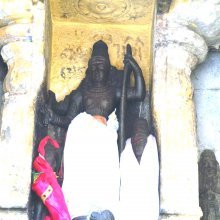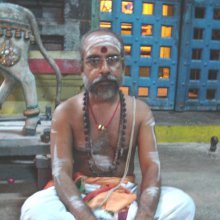Treta, Tretā: 16 definitions
Introduction:
Treta means something in Buddhism, Pali, Hinduism, Sanskrit, Marathi, Hindi. If you want to know the exact meaning, history, etymology or English translation of this term then check out the descriptions on this page. Add your comment or reference to a book if you want to contribute to this summary article.
Images (photo gallery)
In Hinduism
Purana and Itihasa (epic history)
Source: Cologne Digital Sanskrit Dictionaries: The Purana IndexTretā (त्रेता).—At the commencement of this Yuga, Brahmā established the social polity of castes and orders; long life, learning, strength, beauty, health and righteousness were common; in course of time moha made men irreligious and prejudiced; they appealed to Manu who created two sons, Priyavrata and Uttānapāda through Śatarūpā; they were the first kings of the earth; here was the division of the Śamhitā, Mantra, Ṛṣi and Brāhmaṇa; the dharma meant truth, japa, tapas and dāna; the kings were Cakravartins;1 the dharma of;2 see Tretāyuga.

The Purana (पुराण, purāṇas) refers to Sanskrit literature preserving ancient India’s vast cultural history, including historical legends, religious ceremonies, various arts and sciences. The eighteen mahapuranas total over 400,000 shlokas (metrical couplets) and date to at least several centuries BCE.
Kavya (poetry)
Source: archive.org: Naisadhacarita of SriharsaTretā (त्रेता) refers to 1) the age of that name, or 2) the three sacrificial fires (garhapatya, āhavanīya and dakṣiṇa), and is mentioned in the Naiṣadha-carita 17.146.

Kavya (काव्य, kavya) refers to Sanskrit poetry, a popular ancient Indian tradition of literature. There have been many Sanskrit poets over the ages, hailing from ancient India and beyond. This topic includes mahakavya, or ‘epic poetry’ and natya, or ‘dramatic poetry’.
Shaktism (Shakta philosophy)
Source: Google Books: ManthanabhairavatantramTretā (त्रेता) or Tretāyuga refers to the age associated with Jālandhara, one of the sacred seats (pīṭha), according to the Manthānabhairavatantra, a vast sprawling work that belongs to a corpus of Tantric texts concerned with the worship of the goddess Kubjikā.—The Kumārikākhaṇḍa displays most of the many new developments that took place after the revelation of the Kubjikāmatatantra including those concerning the sacred seats. [...] Although the seats are the same five described in the Kubjikāmatatantra and its expansions, their contents [i.e., the Tretā-yuga] and the beings who inhabit them are quite different.

Shakta (शाक्त, śākta) or Shaktism (śāktism) represents a tradition of Hinduism where the Goddess (Devi) is revered and worshipped. Shakta literature includes a range of scriptures, including various Agamas and Tantras, although its roots may be traced back to the Vedas.
In Buddhism
General definition (in Buddhism)
Source: Wisdom Library: Dharma-samgrahaTretā (त्रेता) or Tretāyuga refers to the “threefold-life age” and represents the second of the “four ages” (yuga) as defined in the Dharma-saṃgraha (section 88). The Dharma-samgraha (Dharmasangraha) is an extensive glossary of Buddhist technical terms in Sanskrit (e.g., tretā). The work is attributed to Nagarjuna who lived around the 2nd century A.D.
Languages of India and abroad
Marathi-English dictionary
Source: DDSA: The Molesworth Marathi and English Dictionarytrētā (त्रेता).—f or trētāyuga n (S) The second yuga or age, consisting of 12,96,000 years.
Source: DDSA: The Aryabhusan school dictionary, Marathi-Englishtrētā (त्रेता).—f trētāyuga n The 2nd yuga or age.
Marathi is an Indo-European language having over 70 million native speakers people in (predominantly) Maharashtra India. Marathi, like many other Indo-Aryan languages, evolved from early forms of Prakrit, which itself is a subset of Sanskrit, one of the most ancient languages of the world.
Sanskrit dictionary
Source: DDSA: The practical Sanskrit-English dictionaryTretā (त्रेता).—
1) A triad, triplet.
2) The three sacred fires taken collectively (gārhapatya, dakṣiṇa and āhavanīya); cf. Manusmṛti 2.231; Bhāgavata 9.14.44; त्रेताग्निधूमाग्रमनिन्द्यकीर्ते- स्तस्येदमाक्रान्तविमानमार्गम् (tretāgnidhūmāgramanindyakīrte- stasyedamākrāntavimānamārgam) R.13.37.
3) A particular throw at dice, a cast of three or trey; त्रेताहृतसर्वस्वः (tretāhṛtasarvasvaḥ) Mṛcchakaṭika 2.8.
4) The second of the four Yugas of the Hindus; see युग (yuga).
Source: Cologne Digital Sanskrit Dictionaries: Shabda-Sagara Sanskrit-English DictionaryTretā (त्रेता).—f.
(-tā) 1. The second Yuga or age of the Hindus, consisting of 1,296,000 years. 2. The three sacred fires collectively, or the southern, household, and sacrificial fires. E. tra preservation, &c. derived from trai to preserve, ita obtained, got.
Source: Cologne Digital Sanskrit Dictionaries: Benfey Sanskrit-English DictionaryTretā (त्रेता).— (i. e. probably traya + tā), f. 1. A triad, Mahābhārata 14, 2759. 2. The three sacred fires, Mahābhārata 5, 1559. 3. A die, or the side of a die, which has three points, [Mṛcchakaṭikā, (ed. Stenzler.)] 33, 9. 4. The name of the second yuga, or age, [Mānavadharmaśāstra] 9, 201.
Source: Cologne Digital Sanskrit Dictionaries: Cappeller Sanskrit-English DictionaryTretā (त्रेता).—[feminine] a triad, the three sacred fires, the die or side of the die marked with three points; the second Yuga or age of the world.
Source: Cologne Digital Sanskrit Dictionaries: Monier-Williams Sanskrit-English Dictionary1) Tretā (त्रेता):—f. ([from] traya) and triad, triplet, [Mahābhārata xiv, 2759]
2) the 3 sacred fires (= agni-), [v, 1559; Harivaṃśa 1410]
3) trey (throw at dice or the side of a die marked with 3 spots), [Vājasaneyi-saṃhitā xxx, 18; Taittirīya-saṃhitā iv; Mṛcchakaṭikā ii, 9]
4) ‘age of triads’, the 2nd Yuga (or silver age), [Aitareya-brāhmaṇa; Muṇḍaka-upaniṣad; Śāṅkhāyana-śrauta-sūtra; Manu-smṛti etc.]
Source: Cologne Digital Sanskrit Dictionaries: Yates Sanskrit-English DictionaryTretā (त्रेता):—(tā) 1. f. The second Yug or age; the three sacred fires.
Source: DDSA: Paia-sadda-mahannavo; a comprehensive Prakrit Hindi dictionary (S)Tretā (त्रेता) in the Sanskrit language is related to the Prakrit word: Teā.
[Sanskrit to German]
Sanskrit, also spelled संस्कृतम् (saṃskṛtam), is an ancient language of India commonly seen as the grandmother of the Indo-European language family (even English!). Closely allied with Prakrit and Pali, Sanskrit is more exhaustive in both grammar and terms and has the most extensive collection of literature in the world, greatly surpassing its sister-languages Greek and Latin.
Hindi dictionary
Source: DDSA: A practical Hindi-English dictionaryTretā (त्रेता):—(nm) the second of the four ages according the Hindu mythology—the silver age.
...
See also (Relevant definitions)
Starts with: Tretachandas, Tretagni, Tretagnihotra, Tretalisa, Tretamukha, Tretastoma, Tretatva, Tretaya, Tretayuga.
Ends with: Agnitreta, Majistreta, Netratreta.
Full-text (+110): Tretayuga, Yuga, Agnitreta, Tretagni, Agnayi, Caturyuga, Tretaya, Tretini, Dvaparayuga, Kaliyuga, Tretagnihotra, Tretastoma, Tiretayukam, Tretatva, Tretachandas, Agnitraya, Tiretam, Tredhasthita, Jambavat, Tredhasamnaddha.
Relevant text
Search found 90 books and stories containing Treta, Tretā, Trētā; (plurals include: Tretas, Tretās, Trētās). You can also click to the full overview containing English textual excerpts. Below are direct links for the most relevant articles:
The Skanda Purana (by G. V. Tagare)
Chapter 53 - Origin of Centre of Pilgrimage with Brahmā’s foot < [Section 3 - Arbuda-khaṇḍa]
Chapter 10 - Pilgrimages in the Arbuda region during Kali Yuga < [Section 3 - Arbuda-khaṇḍa]
Chapter 3 - Principal Holy Places in Vastrāpatha < [Section 2 - Vastrāpatha-kṣetra-māhātmya]
Mahabharata (English) (by Kisari Mohan Ganguli)
Section X < [Jambukhanda Nirmana Parva]
Section CXLII < [Bhagavat-Yana Parva]
Section CCXXXI < [Mokshadharma Parva]
The Brihaddharma Purana (abridged) (by Syama Charan Banerji)
Chapter 53 - On the divine year and the Yugas—Length of Brahma’s day
Chapter 56 - A description of the four yogas—Origin of evil
Chapter 62 - A full description of the Kali Yuga or the Iron age
The Garuda Purana (by Manmatha Nath Dutt)
Chapter CCXXXII - Dissolution of the Universe < [Dhanvantari Samhita]
Chapter XV - Enumeration of one thousand epithets of Vishnu < [Agastya Samhita]
Garga Samhita (English) (by Danavir Goswami)
Verse 5.10.4 < [Chapter 10 - The Stories of the Washerman, Weaver, and Florist]
Verse 1.4.35 < [Chapter 4 - Description of Questions About the Lord’s Appearance]

